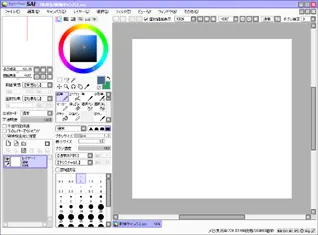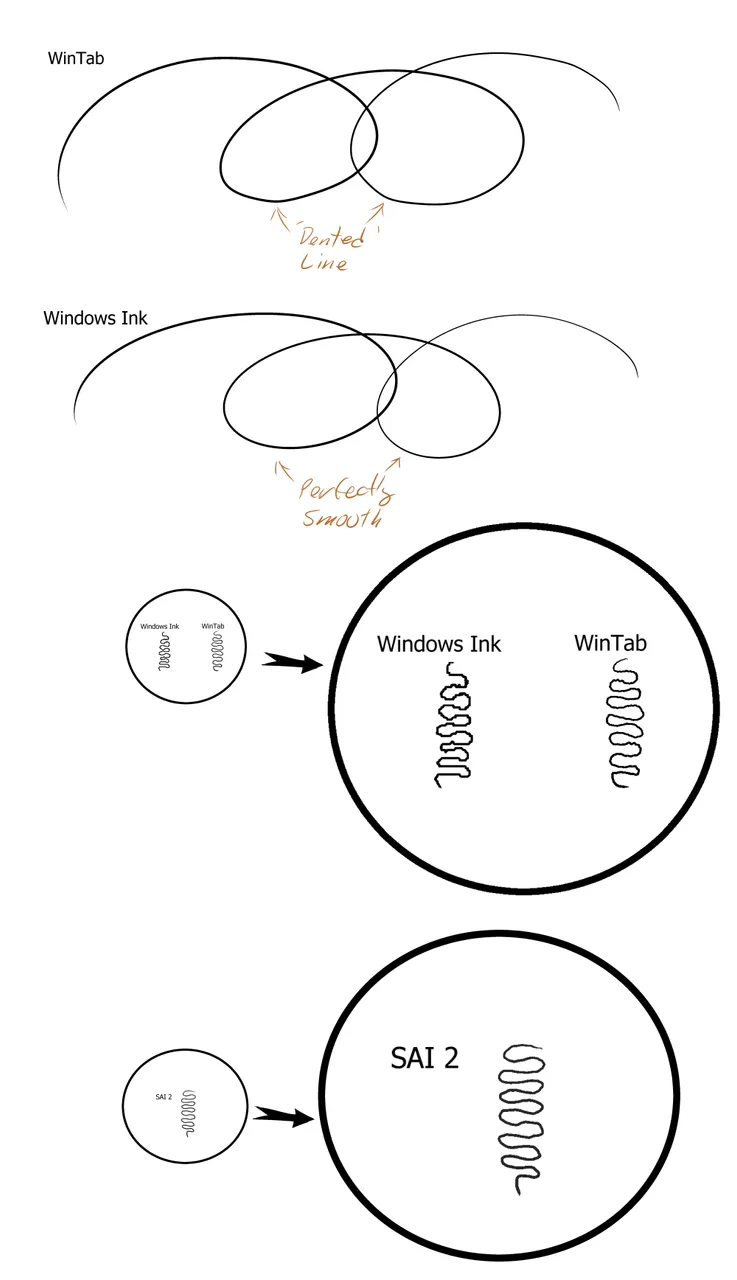Hi everybody!
A quick word to the wise: This post is intended for digital arts geeks, so it might be a teensy bit over-technical for those who don't spend a lot of time working with Wacom Cintiqs, -or the variety of alternative computer drawing boards out there. However, for those of us who DO draw a lot with electronic styluses.., I think this post offers some pretty coolio insights I just discovered!
So...
I made some discoveries while exploring the latest review version of Paint Tool Sai 2. You can download the free technical review copy here: http://www.systemax.jp/en/sai/devdept.html
It's fresh! -Quietly published only a couple of days before the New Year celebrations rang in 2018. And it has come a long way since the last time I looked a it!

(I dug out my old license and it works! -If you don't have a license, you can't import or save files, but you can still play with the software freely.)
Now one of the seriously awesome things about SAI is that where Photoshop and ClipStudio Paint and other developed art software packages are simply massive programs, usually well in excess of 100 Mb and even sometimes pushing into the gigabyte range, SAI is incredibly tiny and light on its feet. Weighing in at just over 5 Mb, it is almost not even there by comparison. You could literally park the whole .exe between some of those random mystery files in ClipStudio Paint (CSP) or Photoshop's (PS) program folders and not even notice it. -And yet it offers all the standard super-powered features of those larger programs. And, here's the thing, it does them faster and better in nearly every case.
And why not? A megabyte is a LOT of space. The entirety of "War and Peace" fits into 3.2 Mb as a text file. That's a lot of room to code.
-I hail from the days when computers maxed out at 4, 16 and 32 Kb, and we still managed to get some seriously fast, powerful things done. When you have a limited computer crunch budget, the ambitious programmer needs to get smart. And they did! The only excuse (other than big included media files) for applications being over 300 Mb is that people are wasteful and, (dare I say it?) sloppy.
Paint Tool SAI is EFFICIENT. And, boy, you can see it; with efficiency, comes speed. SAI is fast. SAI is also a throwback to the old days in another major respect. It is programmed by a lone wolf. One guy! Koji Komatsu programs the software and runs the company all by himself. "Programmer, President". Koji rocks. He is the boss.
Anyway getting back to my main point...
Here's the discovery which came up while I was exploring the technical review copy of SAI 2 which he posted a few weeks ago:
I've noticed that on my Samsung Notebook 9 Pro with Wacom EMR digitizer, there is a tiny bit of jitter that I hadn't seen before (but probably should have). -It's a subtle effect, but if you fix the pen in one spot, you can see that it is definitely there.
That is, when I hold the stylus perfectly still, the cursor will jitter around every second or so by about one pixel's worth of distance from the central point beneath the pen nib. It's a very minor effect and I honestly hadn't noticed it until now, not directly anyway, but rather when I was doing super-tight detail work in CSP where I put it down to something weird in the driver. It's not the driver. It's the hardware. Not cool! This is not supposed to be happening with the Great and Powerful Wacom EMR system. But there it is. It can be observed on all levels of the OS.
Now here's the thing...
The new and popular Windows Ink driver by Microsoft (which is the code allowing many of the modern digital pen systems work) doesn't do anything to correct this micro-jitter, which is why I was unable to draw a reliably clean line when working in very tight areas.
The driver used before Microsoft got into the tablet game was something called WinTab, and it is still used today. -You can even pick between it and Windows Ink when working in ClipStudio Paint. Now WinTab does go some distance in correcting for most of this jitter, disregarding micro-changes in the X,Y coordinates and maintaining a stable cursor. -Which is great, as it allows for super clean line work in tight areas.
However, WinTab and CSP don't play well together; at large sizes and fast brush strokes, CSP exhibits a periodic delay which results in 'dents' when drawing long curved lines. Windows Ink doesn't do this, but does jitter at the micro-level. Between WinTab and Windows Ink, you can get a properly working stylus, but it means switching between the two depending on your needs. That's what we call in the art biz, "Annoying."

Paint Tool SAI when run through the same tests is the clear winner. Using the WinTab driver, it out-performs on both ends of the scale. It is not 100% perfect, but in the digital realm it doesn't get much better than this.
On the down side.., SAI isn't fully integrated yet with finger touch input. It understands the pinch-zoom idea, but not rotate and not even scrolling. If you drag your finger across the canvas, it registers as a line input. So that's definitely an area which could use some improvement.
SAI is also still locked to a full colour paradigm. There is no such thing as a black & white canvas; your file is full colour or nothing. Koji informed his users long ago that he had chosen to go this way because of certain inherent efficiency benefits. -And, boy, you could sure see them! No other software at the time was even close to being as smooth and responsive as SAI. But times have changed, both in terms of the computer power available to users which make such efficiencies less critical, but also for guys like me, where RAM limits are no longer a real concern. -I am now working on a system with 16Gb of memory! That's heeeyuge compared to when I was first trying to get work done with SAI on only 2Gb of ram. So the full-colour only thing isn't really a problem in either sense, -though having the ability to work on black & white canvases would cut out a few steps for me in post production.
Other things about SAI 2...
SAI 2 can save in it's own native format, or in a variety of others, including fully layered Photoshop .psd documents. (Though, you lose any specific text or vector file information in the process; it's all converted to raster graphics upon saving.) And it can't open or create .tif documents. For me that's a pain, since .tif is my default file format for everything I draw or scan. I picked that format exactly because it was a standard across all art software, and has been for decades now. You want something like that so you don't have to worry about formats falling out of vogue over the years and all your archives being unreadable in the future. Or today! (I have run recently into some ridiculous challenges, for instance, trying to open old project layouts created back when I was using QuarkXpress and Adobe PageMaker). So I have thousands of .tif files today and I absolutely want to keep on using them. SAI needs to get that format adopted before I'd give it my full endorsement, for sure!
On the upside... one of the things I really like about SAI is Koji's particular style of GUI design thinking. His work is elegant, minimalist and supremely functional. -For instance, when using the gradient feature to fill an area, SAI 2 instantly creates a real-time preview in the selected spot. You can drag around the cursor and when the gradation looks like what you want, you just release the stylus button and voila! It locks into place. This is such an obvious and useful improvement over the guess work system PS and CSP offer, it amazes me that nobody (including myself) has thought of implementing it before now. SAI 2 is full of little smart bombs like that.
Of course, there are still areas which need refinement; SAI 2 is a beta model after all, but unlike last year, it now resides at a point where I think I can actually use it as a serious production tool.
I'm going to try using it for my next bit of work!
Okay.
That's all I wanted to say. (You can follow my various posts about digital art tech in the http://forum.tabletpcreview.com where I and other digital art nerds post regularly. I just wanted to do an expanded version of this article here for everybody!)
Cheers and have a great day!